Laptop Mag Verdict
The Soundcore Frames perfect the current bluetooth audio eyewear formula with a stylish, comfortable fit, decent speakers and awesome call quality. But, until bone conduction audio makes its way to specs, this expensive formula is no match for a pair of earbuds and some sunglasses.
Pros
- +
Premium design
- +
Comfortable to wear
- +
Replaceable frames
- +
Good microphones for calls
- +
Strong Bluetooth connection
- +
Sound quality is better than you’d expect…
Cons
- -
…but it’s still not as good as earbuds
- -
Average battery life
- -
Finicky touch controls
- -
Loud sound leakage
- -
Expensive
Why you can trust Laptop Mag
Portable audio companies have been trying to crack the next frontier: eyewear. Anker is taking a crack at it with the Soundcore Frames, with hopes to dodge a lot of the fatal flaws of its competition, the Razer Anzu.
Personally, audio glasses have always been the worst of both worlds, because the lack of in-ear contact sacrifices some of the sound quality and the weight of the electronics makes them uncomfortable to wear. To get this kind of product right, you need three things:
Can Soundcore check all of these boxes? Or do audio glasses need a little more time in the oven before hitting prime time? Let’s find out.
Soundcore Frames: Availability and price
Soundcore Frames are available for $199/£149 with a huge range of sunglass and eyeglass frames to select from. If you want to mix it up, additional frames are an extra $49/£49 with plenty of styles available.
The Soundcore Frames smart glasses mostly (barring some select frames) come in three sizes: small, medium or large. Whatever you pick, the prices stay the same and this cost causes the same problems I felt with the Anzu. Compared to picking up a set of earbuds and a set of specs, this is a steep asking price.
Soundcore Frames: Design
Usually, talking about design is pretty open-and-shut, because the gadgets we review usually sport just one look. But the beauty of Soundcore Frames lies in the fact that they can be whatever you want them to be.



You see, the front part of the Frames actually pops off the stems and is swappable with a huge variety of options in different sizes. Whether you want to go for something like a classic pair of Wayfarers, channel your inner Top Gun with aviators or go full Pitbull with this “Festival style,” the choice is yours. The end result is a selection of styles that gives the Frames a chance to appeal to a far wider audience than just going for one look like the Razer Anzu.
That’s not the only advantage these have, though. Anker has shaved a couple of grams off the Razer Anzu (47g/1.7 ounces) for a pair of glasses that weigh 45g (1.6 ounces). It’s a tiny difference and we’re still not near the weight of typical glasses (Ray-Ban Wayfarers weigh 35g/1.2 ounces), but this small weight loss alongside the rounded, ergonomic design of the tech-stuffed stems does make for a noticeable difference to the wearability.
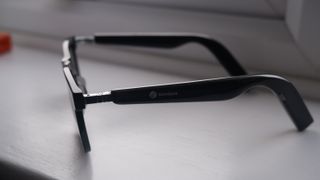
Pair this with an evenly distributed weight throughout the stems, which measure in at a standard 120 millimeters (4.7 inches) and a hinge mechanism that can bend up to 8 degrees to fit pretty much any head size. Throw in IPX4 water resistance, and you have an impressively comfortable pair of specs to wear over longer periods of time.
It’s taken a while for a company to get this right, but Anker has done it. You’re not going to be doing strenuous exercise with these on, as the weight does bounce about on the arch of your ear, but for what these are designed for (everything else), these are ideal.
Soundcore Frames: Controls
You control the Soundcore Frames using touch surfaces on each side of the specs or with voice and, fortunately, both options were fast and responsive with no missed inputs.
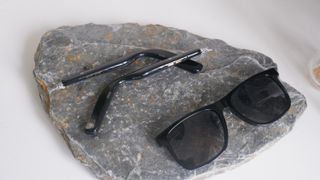
In total, you’ve got six customizable interactions: double taps, and swipes back and forth on each stem. These give you a wealth of operability options, such as skipping tracks, altering the volume and activating Siri or Google assistant. Touches are registered quickly and operation of the Frames is really easy to pick up.
Plus, the voice assistant is entirely local, which means you don’t need an internet connection for the simple requests like picking up the phone or skipping track, which, in the world of always-on smart assistants, is warmly welcomed.
Soundcore Frames: Audio quality
You’ll find four speakers packed into the stems of Soundcore’s Frames: two 25 x 8mm main speakers and two 8mm rear drivers. This provides a surround sound that amplifies the audio around the entire ear and, credit to Anker, these sound better than expected.
Don’t get me wrong, these pale in comparison to a pair of true wireless earbuds, but the clarity is there and the frames deliver a surprising amount of warmth — enough to handle both louder compositions like Four Year Strong’s thunderous cover of “Bittersweet Symphony” and more subtly nuanced music like Chillhop’s Lo-Fi live stream.
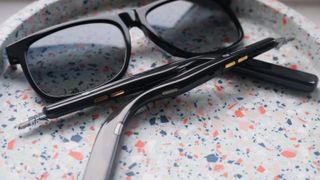
Whatever you throw at these, the soundstage feels fuller than what I experienced on the Razer Anzu, and of course, these are great for the spoken word, too. But there are two problems that come with this traditional method of jamming a speaker into the stem: leakage and the lack of full-bodied sound.
When you’re out and about, your surroundings can very quickly overwhelm whatever you’re listening to, even when turned up. Not only that, but other people can hear what you’re listening to if they are near you (though at the moment, they really shouldn’t be). And, with simple speakers and no in-ear contact, you’ll never get the same detail, definition or depth.
This will continue to be the fundamental flaw for anyone looking for great audio from glasses, which I believe could be fixed in the future with bone conduction technology — transmitting sound through vibrations on bones in your head and jaw. That eliminates the leakage problem, too.
Soundcore Frames: App and special features
The Soundcore app stands alone as the best earbud companion software available today — available for free on iOS and Android.
The user interface is clean and you get easy access to the vast feature set, including a fully customizable EQ, surround sound adjustments, a privacy mode that reduces noise leakage by turning the volume down, and even an option to virtually try on new frames in AR.

Here, you can also customize the controls and flip on wearing detection to save some battery life. All in all, it’s an impressive suite of features, displayed in a user-friendly way.
Soundcore Frames: Battery life
Anker promises “up to 5.5 hours” of playback on a single charge, plus fast charging an additional 1.5 hours of playback with a 10-minute charge. Overall, I found that to be accurate and in summary of a day’s use, it’s average.
Earbuds are easy enough to take out and place in a case to provide more juice, but glasses are different. If you have prescription lenses in here too, you can’t necessarily take them off to charge them up in the middle of a working day. You need them to see!
Speaking of charging, this is done via a proprietary USB cable that connects to the two separate stalks. I reached a full charge in around an hour, so while anyone with prescription glasses will need to carefully time their charging time, you can make these last all morning and all afternoon on a work day.
Soundcore Frames: Call quality and connectivity
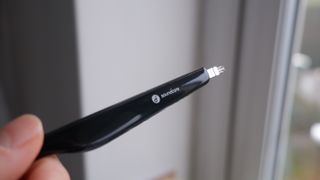
The Soundcore Frames benefit from Bluetooth 5.2, which provides a super strong connection over a long distance. When paired to my MacBook, I had to get at least 40 feet away before audio playback got a little choppy.
For calls, these are fantastic. The microphone placement is closer to your mouth on the stems, and they do a great job of picking up your voice clearly with no distortion. They were especially great at isolating my voice over any background noise, but of course, we run into the same sound leakage issue when it comes to hearing the other end of the call.
Indoors, this is no problem, but take them outside and any kind of breeze can start to make the person talking to you difficult to hear. Again, bone conduction audio would fix this.
Soundcore Frames: Verdict
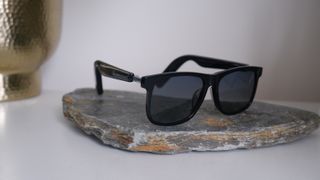
Soundcore has nailed the audio eyewear formula with the Frames, but there’s a problem with the formula.
Don’t get me wrong, this is an awesome idea executed really well: they’re stylish and comfortable, sound better than you expect and the unique customizability is something you can’t find anywhere else.
But these fall victim to the noise leakage, a battery life that doesn’t lend itself to real all-day use and a price point that puts it out of reach of separately buying earbuds and shades, which are going to provide a better listening experience.
The current formula has gone as far as it can. It’s time to move forward and explore the likes of bone conduction audio to make the necessary improvements.

Jason brought a decade of tech and gaming journalism experience to his role as a writer at Laptop Mag, and he is now the Managing Editor of Computing at Tom's Guide. He takes a particular interest in writing articles and creating videos about laptops, headphones and games. He has previously written for Kotaku, Stuff and BBC Science Focus. In his spare time, you'll find Jason looking for good dogs to pet or thinking about eating pizza if he isn't already.
